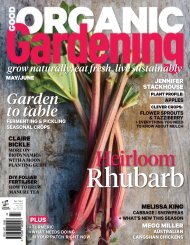1. Good Organic Gardening - January-February 2016
1. Good Organic Gardening - January-February 2016
1. Good Organic Gardening - January-February 2016
Create successful ePaper yourself
Turn your PDF publications into a flip-book with our unique Google optimized e-Paper software.
FAMILY HEIRLOOMS | STRAWBERRIES<br />
Above: ‘Pineapple Crush’<br />
Below: Mixed Alpines from Diggers Club include<br />
‘Mignonette’, ‘White Baron Solemacher’, ‘Red Wonder’,<br />
‘Regina’ and ‘Reine des Vallees’<br />
cascades of petite, wonderfully flavoured<br />
fruit from late spring right through to<br />
early autumn. You might also like to try<br />
‘Regina’ with its heavy crop of sweet,<br />
bite-sized fruit in steady supply from<br />
November right through to March.<br />
For something truly unique, look out<br />
for white-fruiting varieties like ‘Baron<br />
Solemacher’, which displays petite white<br />
strawberries that the birds seem to<br />
ignore. I’m not sure if it’s my imagination,<br />
but the white-fruiting types taste sweeter<br />
to me and you don’t have to net them<br />
with the same commitment as with the<br />
red varieties.<br />
‘Pineapple Crush’ is something really<br />
special, with masses of highly scented<br />
white-yellow fruit with just a hint of<br />
pineapple flavour on a compact, nonrunning<br />
plant. You’ll know the fruit is<br />
ready to harvest when it’s soft and pale<br />
yellow. It’s a great variety to grow if you<br />
want to extend your harvest because the<br />
fruit is heaviest in autumn, just as the<br />
summer croppers are finishing.<br />
For centuries, Europeans<br />
ate woodland strawberries<br />
growing wild on the forest<br />
floor but it was sometime in<br />
the 1300s that the French<br />
began cultivating wild<br />
strawberries in the garden.<br />
Their compact, runnerless form makes them ideal for garden edging<br />
Growing<br />
There are some very good reasons to grow<br />
Alpine strawberries at home, not least of which<br />
is their ability to tantalise the tastebuds. Just<br />
a few ripe fruit can scent the air, announcing<br />
their arrival, which is a big reason they often<br />
don’t make it inside at all.<br />
The ripe crop is staggered over months, so<br />
there’s lots of picking to be done and, because<br />
the fruits are delicate and easy to squish, you<br />
rarely see them in the shops. Their neat growth<br />
habit makes them an excellent choice for pots<br />
and hanging baskets or garden edging.<br />
Like plump modern-day varieties, Alpine<br />
strawberries grow best in rich, fertile, welldrained<br />
soil. They can be grown from seed<br />
sown during spring or summer and they<br />
enjoy sunny spots but will benefit from part<br />
shade in hot areas.<br />
Feed and water regularly, particularly when<br />
the fruit is setting, and they’ll crop well for<br />
three or so years. Ripe Alpine strawberries<br />
last only a short time, so visit your strawberry<br />
patch regularly to pick the fully ripe, fully<br />
coloured fruit.<br />
Alpine strawberries are smaller and<br />
less juicy than modern varieties, but their<br />
abundant foliage, delicate texture and scented,<br />
flavoursome fruit make a winning combination.<br />
Because the temptation is so great to pick and<br />
eat them fresh from the plant, you rarely get<br />
enough to use in the kitchen. If some manage<br />
to make it indoors, I think they are best eaten<br />
simply with a dollop of cream or ice-cream or<br />
— dare I say it — just a sprinkle of sugar.<br />
For more information, visit diggers.com.au<br />
Pick daily as they don’t last long<br />
Unripe ‘Fraises des Bois’<br />
24 | <strong>Good</strong> <strong>Organic</strong> <strong>Gardening</strong>
















